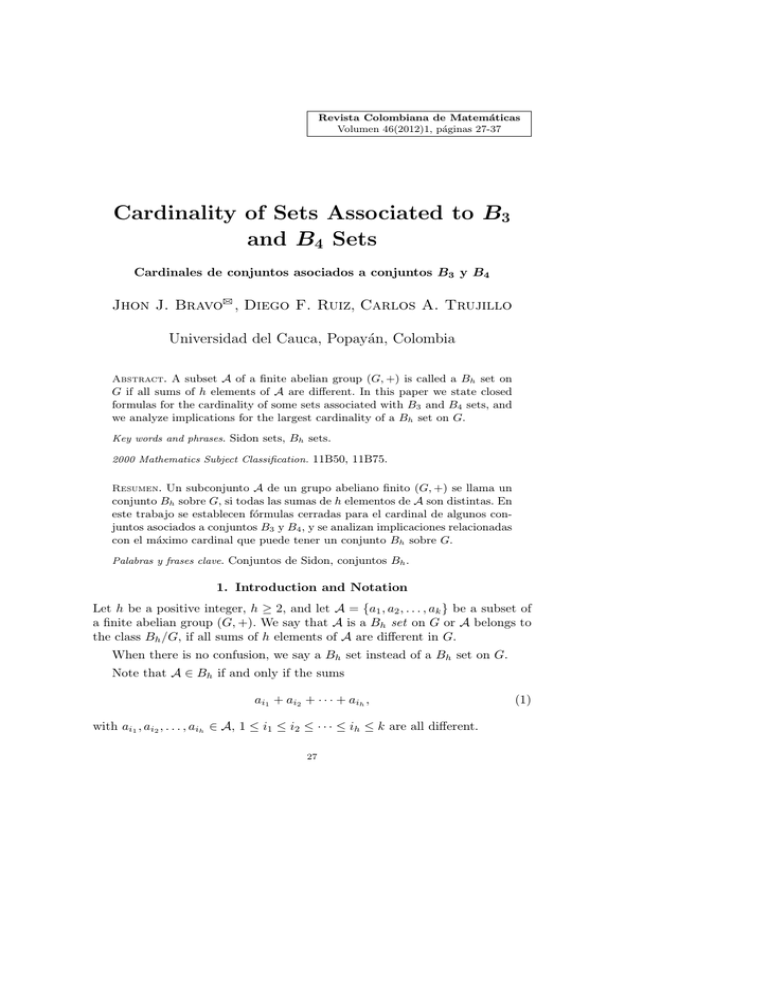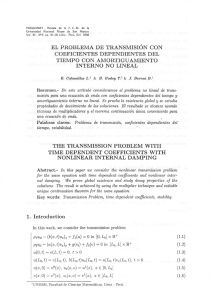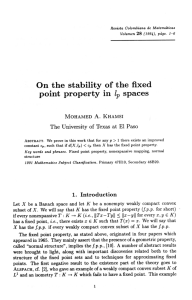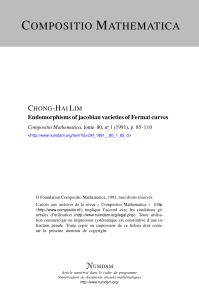English - SciELO Colombia
Anuncio

Revista Colombiana de Matemáticas
Volumen 46(2012)1, páginas 27-37
Cardinality of Sets Associated to B3
and B4 Sets
Cardinales de conjuntos asociados a conjuntos B3 y B4
Jhon J. BravoB , Diego F. Ruiz, Carlos A. Trujillo
Universidad del Cauca, Popayán, Colombia
Abstract. A subset A of a finite abelian group (G, +) is called a Bh set on
G if all sums of h elements of A are different. In this paper we state closed
formulas for the cardinality of some sets associated with B3 and B4 sets, and
we analyze implications for the largest cardinality of a Bh set on G.
Key words and phrases. Sidon sets, Bh sets.
2000 Mathematics Subject Classification. 11B50, 11B75.
Resumen. Un subconjunto A de un grupo abeliano finito (G, +) se llama un
conjunto Bh sobre G, si todas las sumas de h elementos de A son distintas. En
este trabajo se establecen fórmulas cerradas para el cardinal de algunos conjuntos asociados a conjuntos B3 y B4 , y se analizan implicaciones relacionadas
con el máximo cardinal que puede tener un conjunto Bh sobre G.
Palabras y frases clave. Conjuntos de Sidon, conjuntos Bh .
1. Introduction and Notation
Let h be a positive integer, h ≥ 2, and let A = {a1 , a2 , . . . , ak } be a subset of
a finite abelian group (G, +). We say that A is a Bh set on G or A belongs to
the class Bh /G, if all sums of h elements of A are different in G.
When there is no confusion, we say a Bh set instead of a Bh set on G.
Note that A ∈ Bh if and only if the sums
ai1 + ai2 + · · · + aih ,
with ai1 , ai2 , . . . , aih ∈ A, 1 ≤ i1 ≤ i2 ≤ · · · ≤ ih ≤ k are all different.
27
(1)
28
JHON J. BRAVO, DIEGO F. RUIZ & CARLOS A. TRUJILLO
If A and B are subsets of G, then the sum set and the difference set are
defined as usual; i.e.,
A + B := {a + b : a ∈ A, b ∈ B},
A − B := {a − b : a ∈ A, b ∈ B}.
We also define the negative set of A as
−A := {−a : a ∈ A}.
When B = A, we write 2A = A+A. Throughout this paper, for any r ∈ Z+ ,
we use the following notation:
r · A := {ra : a ∈ A},
rA := {a1 + · · · + ar : a1 , . . . , ar ∈ A},
rbA := {a1 + · · · + ar : a1 , . . . , ar ∈ A, all of them different}.
In addition to this, if s ∈ Z+ , we define
rbA ⊕ sbA := (a1 + · · · + ar ) + (a01 + · · · + a0s ) : ai , a0j ∈ A,
{a1 , . . . , ar } = r, {a01 , . . . , a0s } = s,
{a1 , . . . , ar } ∩ {a01 , . . . , a0s } = ∅ ,
rbA sbA := (a1 + · · · + ar ) − (a01 + · · · + a0s ) : ai , a0j ∈ A,
{a1 , . . . , ar } = r, {a01 , . . . , a0s } = s,
{a1 , . . . , ar } ∩ {a01 , . . . , a0s } = ∅ ,
r · A ⊕ s · A := (ra) + (sa0 ) : a, a0 ∈ A, a 6= a0 ,
r · A s · A := (ra) − (sa0 ) : a, a0 ∈ A, a 6= a0 ,
rbA ⊕ s · A := (a1 + · · · + ar ) + (sa0 ) : a1 , . . . , ar , a0 ∈ A
{a1 , . . . , ar } = r, a0 ∈
/ {a1 , . . . , ar } ,
rbA s · A := (a1 + · · · + ar ) − (sa0 ) : a1 , . . . , ar , a0 ∈ A
{a1 , . . . , ar } = r, a0 ∈
/ {a1 , . . . , ar } .
So, if A is a Bh set, then
hA =
|A| + h − 1
,
h
where |X | denotes the cardinality of a finite set X .
The main problem in the study of Bh sets consists of stating the maximal
cardinality of a Bh set on G. The natural step to follow is to analyze the
asymptotic behavior of the function
fh (G) := max |A| : A ∈ Bh /G
as |G| → ∞.
Volumen 46, Número 1, Año 2012
CARDINALITY OF SETS ASSOCIATED TO B3 AND B4 SETS
29
If G is a finite group with N elements, then we sometimes write fh (G) =
fh (N ).
With the following counting we state an upper bound for the function
fh (G).
In fact, if A is a subset of G with |A| = k, then there are k+h−1
sums
of the
h
form (1) in G, and if A is a Bh set on G, all these sums are different, so that
k+h−1
kh
≤
≤ |G|
h!
h
from which we obtain the trivial upper bound
1/h
fh (G) ≤ (h!)
Hence
|G|
1/h
.
fh (G)
≤ (h!)1/h .
lim sup p
h
|G|
|G|→∞
In this paper we state closed formulas for the cardinality of some sets related
to B3 and B4 sets, and we analyze implications associated with the functions
f3 (G) and f4 (G), being G a finite abelian group.
We start our study with the case h = 2, where the sets are well–known as
Sidon sets.
2. The Case h = 2: Sidon sets
Let G be a finite commutative group and let A be a Sidon set on G with
|A| = k. Associated with A and h = 2, we have the sets
2A = A + A := a + b : a, b ∈ A ,
A − A := {a − b : a, b ∈ A},
b
2A = A ⊕ A := {a + b : a, b ∈ A, a 6= b},
A A := {a − b : a, b ∈ A, a 6= b}.
Since a + b = c + d ⇔ a − d = c − b, the Sidon sets are defined as such
sets with the property that all non–zero differences of elements of that set are
different. Thus, if A is a Sidon set, then
k+1
k
|A + A| =
=
+ k,
2
2
k
|A − A| = 2
+ 1 = k(k − 1) + 1,
2
k
|A ⊕ A| =
,
2
k
|A A| = 2
= 2|A ⊕ A|.
2
Revista Colombiana de Matemáticas
30
JHON J. BRAVO, DIEGO F. RUIZ & CARLOS A. TRUJILLO
These equalities can be applied to the study of the function f2 (G). In this
case we obtain the following result.
Theorem 1. If A is a Sidon set on G, with |A| = k and |G| = N , then
k(k − 1) ≤ N − 1.
Proof. It follows from |A − A| ≤ |G|.
X
Observe from Singer’s construction in [2] that we can obtain the equality
k(k − 1) = N − 1
for infinite values of N and k.
Corollary 2. The function f2 (G) satisfies
f2 (G)
≤ 1.
lim sup p
|G|
|G|→∞
3. The Case h = 3: B3 Sets
In this section, let G be a finite commutative group and let A be a B3 set on
G with |A| = k. Associated with A and h = 3 we have the following sets
A + A + A = 3A,
A⊕A⊕A=b
3A,
A + A − A = 2A − A,
A⊕AA=b
2A A,
and their negatives −(3A), − b
3A , A − 2A, A b
2A, respectively. The idea is
to determine closed formulas for the cardinality of such sets and use them to
obtain upper bounds for the function f3 (G).
From the definition of a B3 set, we state the cardinality of the first two sets
k
b
3A = k + 2
and
3A =
.
3
3
The following theorem shows us formulas for the cardinality of the sets
b
2A A and 2A − A.
Theorem 3. If A is a B3 set on G with |A| = k, then
k
k
b
3A,
2A A =
(k − 2) = 3
= 3 b
2
3
2A − A = 3 k + 2 k + k .
3
2
1
Volumen 46, Número 1, Año 2012
CARDINALITY OF SETS ASSOCIATED TO B3 AND B4 SETS
31
Corollary 4. The function f3 (G) satisfies
√
f3 (G)
3
≤ 2.
lim sup p
3
|G|
|G|→∞
Proof. Since 2A − A ⊆ G, we get that
k
k
k
3
+2
+
= |2A − A| ≤ |G|,
3
2
1
and so,
1
k−
3
3
≤ k (k 2 − k + 2) ≤ 2|G|.
In particular
3
1
≤ 2|G|.
f3 (G) −
3
X
3.1. Proof of Theorem 3
In order to prove Theorem 3, we need some auxiliary lemmas.
Lemma 5. Let G be a group and let A be a subset of G. Then
2A = b
2A ∪ 2 · A,
2A − A = b
2A A ∪ (2 · A A) ∪ A,
3A = b
3A ∪ (2 · A ⊕ A) ∪ 3 · A.
Proof. Note that the sets of the right hand sides are contained in the sets of
the left hand sides. Since the other containments are easy to prove, we just show
one case. For example, in the second formula, if x ∈ 2A − A, then x = a + b − c
for some a, b, c ∈ A. If a, b, and c are all different, then x ∈ b
2AA; if a = b 6= c,
X
then x ∈ 2 · A A, while in other cases x ∈ A.
Lemma 6. If A is a B3 set, then the unions in each one of the expressions in
Lemma 5 are pairwise disjoint.
Proof. Since A is a B3 set, it follows that A is a B2 set, thus b
2A ∩ (2 ·
A) = ∅. Using the definition of a B3 set, the proof that the other sets are
pairwise disjoint is not difficult,
so we just prove one of them. We shall prove,
for instance, that b
2AA ∩(2·AA) = ∅. Indeed, if x ∈ b
2AA ∩(2·AA),
then x = (a + b) − c = (d + d) − e for some a, b, c ∈ A all of them different,
and d, e ∈ A with d 6= e. Therefore a + b + e = d + d + c, and because A is a
B3 set, we get that {a, b, e} = {d, c}; that is, e = c and a = b = d, which is not
X
possible.
Revista Colombiana de Matemáticas
32
JHON J. BRAVO, DIEGO F. RUIZ & CARLOS A. TRUJILLO
Proof of Theorem 3. Using Lemma 5 and Lemma 6, it is enough to see that
if A is a B3 set with cardinality k, then
k
k
b
2A A =
(k − 2) = 3
,
2
3
k
X
|2 · A A| = k(k − 1) = 2
.
2
So far we have shown closed formulas for all the sets with h = 3 iterations
of sum sets and difference sets, related to a B3 set. Note that by definition of
B3 sets, we have
k+2
|3A| =
= | − 3A|,
3
and using Theorem 3 we get that
k
k
k
|2A − A| = 3
+2
+
= |A − 2A|.
3
2
1
Finally, the last equality of Lemma 5 and the pairwise disjoint of the sets
involved there, imply that
k+2
= |3A| = b
3A ∪ (2 · A ⊕ A) ∪ 3 · A
3
= b
3A + |2 · A ⊕ A| + |3 · A|
k
k
k
=
+2
+
.
3
2
1
4. The Case h = 4: B4 Sets
Similarly as before, let G be a finite commutative group and let A be a B4 set
on G with cardinality k. Associated with A and h = 4 we get the following sets
4A,
b
4A,
2A − 2A,
b
2A b
2A,
3A − A,
b
3A A,
(2)
and their negatives −(4A), − b
4A , A − 3A, A b
3A. For each one of them, in
this section we show closed formulas for their cardinality and we use them to
determine upper bounds for the function f4 (G). Using the definition of a B4
set, we can state formulas for the cardinality of the sets 4A and b
4A immediately
as follows:
k+3
k
b
|4A| =
and
4A =
.
4
4
In the following theorem we establish closed formulas for the cardinality of
the other sets given in (2).
Volumen 46, Número 1, Año 2012
CARDINALITY OF SETS ASSOCIATED TO B3 AND B4 SETS
33
Theorem 7. If A is a B4 set on G with |A| = k, then
k
k
k
|2A − 2A| = 6
+6
+4
+ 1,
4
3
2
k
k
k
k
|3A − A| = 4
+6
+3
+
,
4
3
2
1
k
b
4A,
= 6 b
2A b
2A = 6
4
k
b
3A A = 4
= 4 b
4A.
4
Corollary 8. The function f4 (G) satisfies
f4 (G) √
lim sup p
≤ 2.
4
|G|
|G|→∞
Proof. Since 2A − 2A ⊆ G, then
k
k
k
6
+6
+4
+ 1 = |2A − 2A| ≤ |G|.
4
3
2
Hence
k(k − 1) k 2 − k + 6 ≤ 4(|G| − 1),
X
from which we obtain the desired result.
4.1. Proof of Theorem 7
To prove Theorem 7 we need to use the following auxiliary lemmas.
Lemma 9. Let G be a group and let A be a subset of G. Then
2A − 2A =
b
2A b
2A ∪ ± b
2A 2 · A ∪ (2 · A 2 · A) ∪ (A A) ∪ {0}
(3)
3A − A = b
3A A ∪ (2 · A ⊕ A A) ∪ (3 · A A) ∪ (A ⊕ A) ∪ (2 · A),
where
2 · A ⊕ A A := {2a + b − c : a, b, c ∈ A, all of them different}.
Furthermore
4A = b
4A ∪ b
2A ⊕ 2 · A ∪ (A ⊕ 3 · A) ∪ (2 · A ⊕ 2 · A) ∪ (4 · A).
(4)
Revista Colombiana de Matemáticas
34
JHON J. BRAVO, DIEGO F. RUIZ & CARLOS A. TRUJILLO
Proof. Clearly, the sets at all right hand sides are contained in the sets of the
corresponding left hand sides. The other containments are not hard to prove.
In fact, for (3), if x ∈ 2A − 2A, then x = (a + b) − (c + d) for some a, b, c and
d ∈ A. We now consider all possible cases for the elements a, b, c, and d.
If a, b, c, and d are all different, then x ∈ b
2A b
2A; if a 6= b and a, b 6= c =
d,
2A 2 · A ; if
then x ∈ b
2A 2 · A; if a = b 6= c, d with c 6= d, then x ∈ − b
a = b 6= c = d, then x ∈ 2 · A 2 · A; if a 6= b and c 6= d with |{a, b} ∩ {c, d}| = 1,
then x ∈ A A. Finally, if a = b = c = d, then x = 0, so, the proof of this
X
equality is finished. A similar argument shows the other equalities.
Lemma 10. If A is a B4 set, then the unions in each one of the expressions
in Lemma 9 are pairwise disjoint.
2A b
2A ∩ (2 · A 2 · A) = ∅. The other cases are
Proof. We show that b
proven in a similar way.
2A b
2A ∩ (2 · A 2 · A), then x = (a + b) − (c + d) = (e + e) − (f + f )
If x ∈ b
for some a, b, c, and d in A all of them different, and e, f ∈ A, e 6= f . Therefore
a + b + f + f = e + e + c + d, but A is B4 , so {a, b, f } = {e, c, d}, which is not
X
possible.
Proof of Theorem 7. Suppose A ∈ B4 with cardinality k. By Lemma 9 and
Lemma 10 we get that:
k
k−2
k
b
b
=6
,
2A 2A =
2
2
4
k
k
b
(k − 2) = 3
= 2 · A b
2A,
2A 2 · A =
3
2
k
X
|2 · A 2 · A| = k(k − 1) = 2
= |A A|.
2
Thus we have given formulas for all the sets with h = 4 iterations of sum
sets or difference sets, associated with a B4 set. By the definition of a B4 set
and Theorem 7, we have
k+3
|4A| =
= | − 4A|
4
and
k
k
k
|2A − 2A| = 6
+6
+4
+ 1,
4
3
2
k
k
k
k
|3A − A| = 4
+6
+3
+
,
4
3
2
1
Volumen 46, Número 1, Año 2012
CARDINALITY OF SETS ASSOCIATED TO B3 AND B4 SETS
35
respectively. On the other hand, by (3) in Lemma 9 and because of the fact
that the unions are pairwise disjoint, we can state a formula for the cardinality
of the set 4A. That is
k+3
4A ∪ (2 · A ⊕ b
2A) ∪ (3 · A ⊕ A) ∪ (2 · A ⊕ 2 · A) ∪ (4 · A)
= |4A| = b
4
2A + |3 · A ⊕ A| + |2 · A ⊕ 2 · A| + |4 · A|
4A + 2 · A ⊕ b
= b
k
k
k
k
=
+
(k − 2) + k(k − 1) +
+
4
2
2
1
k
k
k
k
=
+3
+3
+
.
4
3
2
1
5. Concluding Remarks
In this work we have shown exact formulas in order to determine the cardinality
of some sets in the classes B3 and B4 on a finite abelian group G. Choosing
those formulas that are maximal, we obtained the best upper bounds known
for the extreme functions f3 (G) and f4 (G).
Note that there is still work to be done, some of which is presented as
follows.
5.1. The General Case
What can be done to determine the cardinality of the set sA − tA, where s
and t are positive integers and A is a Bh set, with h = s + t?. To answer this
question, it is important to perform a similar work to that carried out in this
work for B3 and B4 sets; that is, writing sA − tA as a disjoint union and then
studying the cardinality of each one of the sets appearing in that expression.
So far, we have that if A is a Bs+t set with |A| = k, then
k
k−s
sbA b
tA =
≤ |G|
s
t
so,
k!
(k − s)!
k!
·
=
≤ |G|.
(k − s)! s! (k − s − t)! t!
(k − s − t)! s! t!
Hence
(k − s − t + 1)s+t ≤ s! t! |G|.
(5)
If s = t, from (5) we obtain
(k − 2s + 1)2s ≤ (s!)2 |G|,
which implies that
f2s (G) ≤ (s!)1/s |G|1/2s + 2s − 1.
Revista Colombiana de Matemáticas
36
JHON J. BRAVO, DIEGO F. RUIZ & CARLOS A. TRUJILLO
If t = s − 1, we can also use (5) to obtain
(k − 2s + 2)2s−1 ≤ s! (s − 1)! |G|.
In this case we find the upper bound
f2s−1 (G) ≤ (s!(s − 1)!)1/(2s−1) |G|1/(2s−1) + 2s − 2.
It is important to remark that based on the work of Jia [3], Chen [1] studied
the function fh (ZN ) = fh (N ) and he obtained the bounds
f2s (N ) ≤ (s!)2 N 1/2s + O(1),
and
1/(2s−1) 1/(2s−1)
f2s−1 (N ) ≤ s(s − 1)!
N
+ O(1).
Our arguments generalize the results of Chen to finite commutative groups.
Additionally to this, we make a proposal for the constants O(1).
5.2. How Can We Improve Results in B3 and B4 Sets?
Let A be a B3 set on G with cardinality k and B = b
2A A. By Theorem 3 we
know that
k
k
|B| = | − B| =
(k − 2) = 3
.
2
3
However, the sets B and −B are not disjoint sets. In this sense it would be
appropriate to obtain good upper bounds for the cardinality of the set B∩(−B).
Our computational evidence shows us that
B ∩ (−B) ≤ |B| ,
2
and if it were true, we would get that
9 k
≤ |B| + | − B| − |B ∩ (−B)| = |B ∪ (−B)| ≤ |G|,
2 3
where we have also used the fact that B ∪ (−B) ⊆ G. Thus
(k − 2)3 ≤ k (k − 1)(k − 2) ≤
4
|G|,
3
and so,
1/3
4
f3 (G) ≤
|G|1/3 + 2.
3
With this argument we would improve the upper bound found in Corollary 4, being this the best upper bound known so far. For this reason, we
propose the next conjecture.
Volumen 46, Número 1, Año 2012
CARDINALITY OF SETS ASSOCIATED TO B3 AND B4 SETS
37
Conjecture 11. The function f3 (G) satisfies
r
f3 (G)
3 4
≤
.
lim sup p
3
3
|G|
|G|→∞
Finally, in the case of B4 sets, we suggest finding upper bounds for the
cardinality of the set
b
3A A .
2A 2A ∩ b
Acknowledgement. The authors thank the Universidad del Cauca for the
support under research project VRI 2551.
References
[1] Sheng Chen, On the Size of Finite Sidon Sequences, Proceedings of the
AMS 121 (1994), no. 2, 353–356.
[2] A. Gómez and C. Trujillo, Una nueva construcción de conjuntos Bh modulares, Matemáticas: Enseñanza Universitaria 19 (2011), no. 1, 53–62.
[3] X. D. Jia, On Finite Sidon Sequences, Journal of Number Theory 44 (1993),
no. 1, 84–92.
(Recibido en junio de 2011. Aceptado en mayo de 2012)
Departamento de Matemáticas
Universidad del Cauca
Calle 5 No. 4-70
Popayán, Colombia
e-mail: jbravo@unicauca.edu.co
e-mail: dfruiz@unicauca.edu.co
e-mail: trujillo@unicauca.edu.co
Revista Colombiana de Matemáticas


